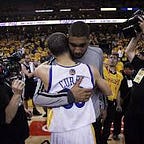Is Kevin Hayes Ready To Be A Top-Six Center?
The 25-year-old is in position to be a top-six player for the Rangers next season, but can he handle the role?
The New York Rangers traded Derek Stepan and Antti Raanta to the Arizona Coyotes for the 7th overall pick in the NHL Entry draft and 21-year-old right-handed defenseman Anthony DeAngelo on Friday. The deal was more of a salary dump, as the Rangers wanted to move Stepan’s $6.5 million cap hit and upcoming no-trade clause. The Blueshirts now have $20 million (and potentially $23 million if defenseman Kevin Klein retires like he’s expected to do) in cap space. But what they don’t have is a top-six center to play the heavy minutes Stepan did.
Love or hate Derek Stepan, you can’t deny he was a good top-six center who could play tough minutes. While not an aesthetically pleasing player to watch, he still notched 50+ points in every season he played while playing in every situation and playing against top competition. Below are some statistics, courtesy of @WoodGuy55 on Twitter, for “tough minute”, or shutdown, centers.
Some of those numbers will surprise people, like Stepan having a higher PTS/60 than Patrice Bergeron, Anze Kopitar, Ryan O’Reilly, and Paul Stastny, all of whom have higher salaries than Stepan. Stepan’s possession metrics also fared well against top competition, as seen in the first two tweets.
Which brings us to the key question: is Kevin Hayes ready to take on Stepan’s role as the Rangers “tough minutes” center? Well, Jeff Gorton certainly thinks so.
The Rangers clearly think Mika Zibanejad is the offensive-driving center they’ve been searching for, but that doesn’t mean he’ll be handling tough matchups. The best teams in the league usually have two centers; one to drive the offense, and the other to stop their opponent’s offense. The best example of this is the Anaheim Ducks and how they use Ryan Getzlaf and Ryan Kesler.
So let’s delve into the numbers to see if Hayes can really fill the matchup role. To do this, we’ll be looking at the quality of competition metrics that both Stepan and Hayes played against, as well as their corsi, zone starts, and face-off numbers. Stepan’s OppGF60 (opponents goals per 60 minutes) was 2.35, the highest on the Rangers. But Hayes wasn’t far behind, as his OppGF60 was 2.32. Stepan’s OppCF60 (opponents corsi per 60 minutes) was 55.85, once again the highest among Rangers forwards. Once again, however, Hayes wasn’t far behind; his OppCF60 was 55.42 (All numbers via Puckalytics.com).
So, even though Stepan received more minutes against top competition, Hayes wasn’t far behind. The difference is Stepan was still able to drive a line despite playing those heavy minutes. Stepan’s CF% was 50.68 while Hayes’ was 43.14, lowest among qualified Rangers’ forwards. Hayes’ subpar possession numbers are also an indication of where he was starting most of his shifts; Hayes started 37.56% of his shifts in the defensive zone, per Puckalytics, by far the highest among Rangers’ centers.
As for face-offs, which everyone is obsessed with in Rangers land, Hayes was at 45.7% this season, winning 48.5% of his offensive zone draws, 45.7% of his defensive zone draws, and 43.7% of his neutral zone draws. Hayes became a trusted penalty killer for Alain Vigneault this season, and he won 46.8% of his shorthanded draws, which is slightly above the 44.8% league average mark. As for Stepan, who everyone creams because he “can’t win a draw”, he won 47% of his total draws, 46.3% in the offensive zone, 49.3% in the defensive zone, 45.5% in the neutral zone, and 37.7% shorthanded. Furthermore, the fantastic stat NSPF/FO (net shots post-faceoff, per face-off, which you can read more about here), shows that Stepan (0.0216 NSPF/FO) was much higher than Hayes’ (-.0091 NSPF/FO) but again, that can be attributed to Hayes starting more of his shifts in the defensive zone than Stepan. When taking a higher percentage of defensive zone draws, it is more likely you’ll be giving up more shots than you are taking. (All face-off number courtesy of PuckBase.com)
Basically, Hayes got tough minutes from Vigneault last season, and despite registering career-highs in assists and points, the underlying numbers weren’t favorable to him. Much of Hayes’ point totals can be attributed to Michael Grabner’s extraordinary 27 goal season where he shot a career-high 16.7%, well above his 12.7% career average. His goal totals are almost certainly to regress this upcoming season.
Now, what will the Rangers do if they don’t believe Hayes is ready for this role? Well, they’ve been rumored to have interest in Jumbo Joe Thornton, but he turns 38 in a week and his knee is like Tom Hanks in Castaway.
Outside of Thornton and Martin Hanzal, who is a fine player, there aren’t any top-flight centers on the free agent market. As for making a trade, the Rangers don’t have the roster assets to go get a Matt Duchene or Nathan Mackinnon without significantly weakening another area of their team.
Like it or not, we’re going to see Kevin Hayes playing a bigger role this season. He received tougher matchups than it appeared last season, but he’s still been plagued by inconsistency throughout his three years in the NHL. He’s 25-years-old now, and is entering the last year of his two-year bridge-deal with a $2.6 million cap hit. There’s no doubt the Rangers want to see if Hayes can be a top-six center before committing to him long-term next summer, but if he’s not ready, the Rangers are going to suffer big time.
